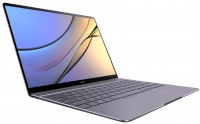Laptops Huawei series MateBook D (for work)
MateBook D
The most numerous line in the assortment of the Chinese giant, which, in fact, gave rise to the laptop division of Huawei. It includes models with screens ranging from 14 to 16 inches and a huge number of combinations of hardware, but in general, these are the most affordable laptops for study and work. If we take out a couple of models of the “almost premium” class, then for the most part these are classic laptops with not the most mobile performance (the case weighs about 1.5 - 2 kg, thickness is 20 mm and above) and balanced equipment that does not try to cause wow in the user -effect, causing him to immediately run to the store.
 |
For example, they still have USB 2.0 ports, which are great for connecting peripherals, but scare marketers. Also, in their ranks, models with card readers, keyboard backlight or branded acoustics are rarely found. At the same time, many models have a fingerprint scanner, a Wi-Fi 6 module, fast charging (sometimes even via USB-C), a webcam built right into the screen, and an NFC that is not quite familiar to such devices. With it, the user can connect an Honor or Huawei smartphone to a laptop in a couple of clicks, and then exchange files over the air like in AirDrop or broadcast the smartphone screen to the laptop.
Another advantage of the MateBook D line is the rich choice of hardware platform. There are models based on familiar Intel chips, and on less common AMD processors in the laptop environment, which are fighting their way into the mobile market. Their charm lies in the use of rather powerful Vega integrated video graphics, which can run not only solitaire with a kerchief, but also play more or less recent games like Sifu, It Takes Two and Kena: Bridge of Spirits at 720p resolution. Otherwise, MateBook D configurations based on both chips are entry-level and provide decent, but not record-breaking performance in everyday tasks. Usually, it includes 8 GB of RAM and an SSD from 256 to 512 GB.



